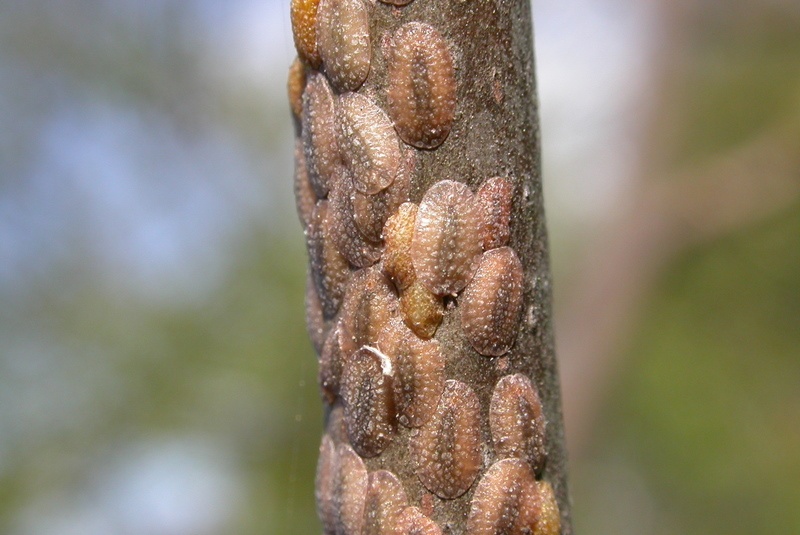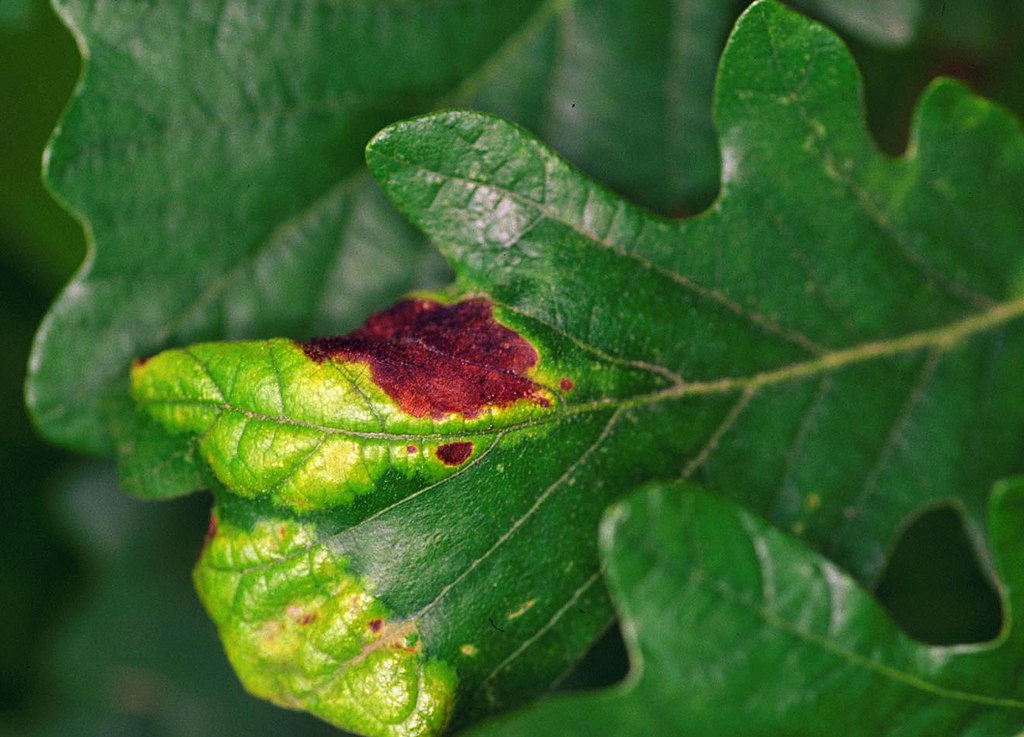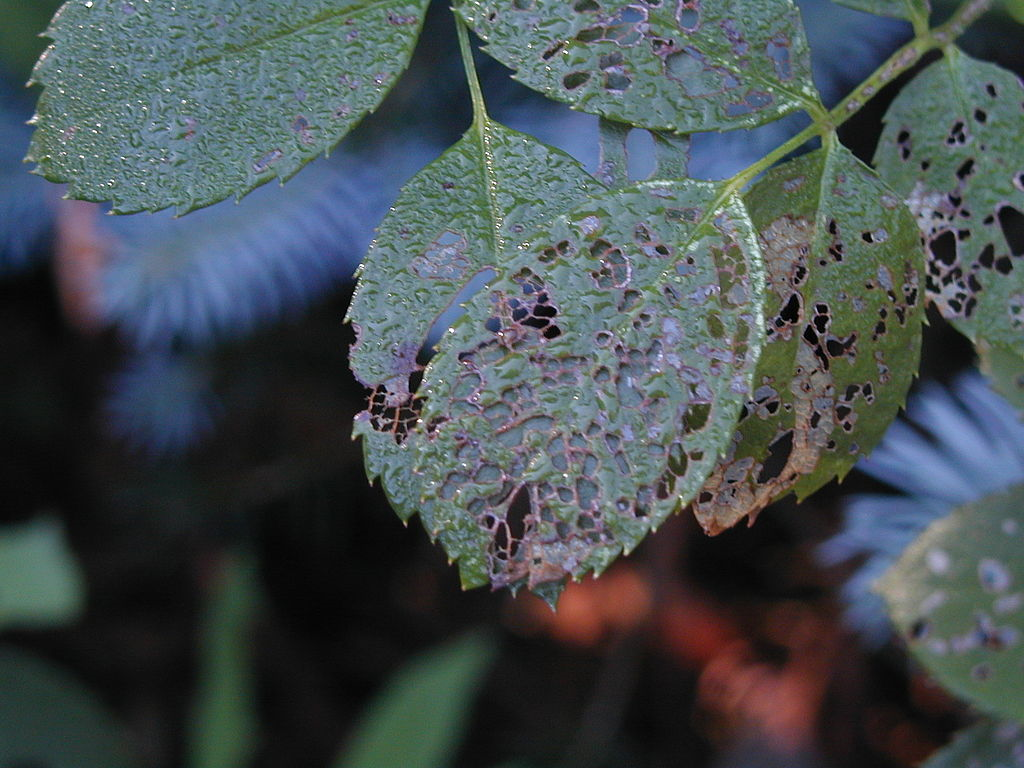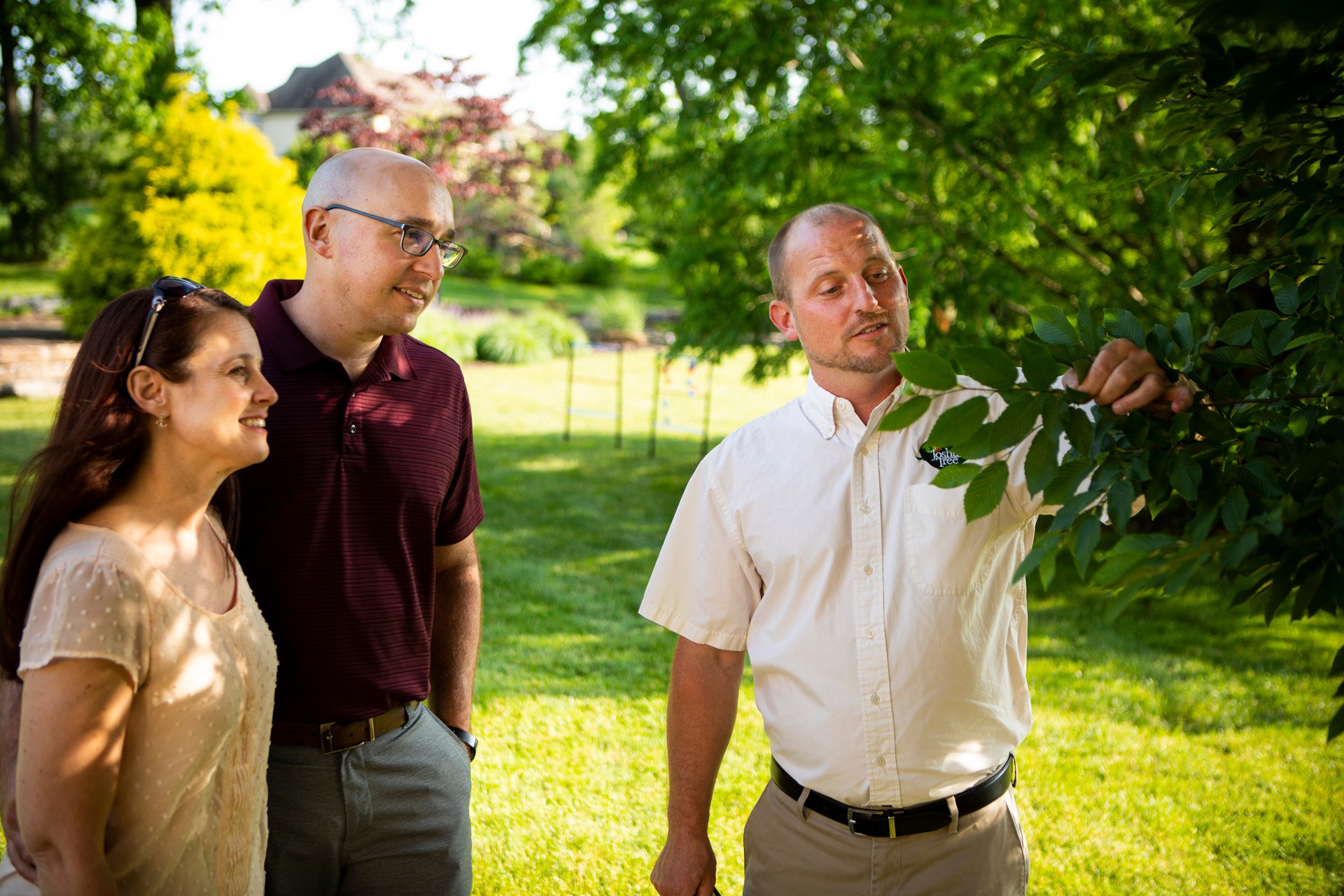The trees and shrubs on your property are important to you and the last thing you want to see is their decline. If you’re noticing shrub and tree problems, you might be wondering if you have a pest, disease, or nutritional issue and how it should be addressed.
We commend you for keeping an eye on the plant material on your property. In fact, it’s something that we encourage our clients to do. Spotting signs of trouble early on could potentially make a difference in saving it.We’ve rounded up 5 signs of a pest, disease, or nutritional problem with your trees and shrubs.
There is Sticky Stuff on the Branches
Are you seeing some sticky substances on your plants? It might look as though the plant is “shiny” or “wet.”
That “sticky stuff” is actually honeydew, a substance excreted from certain insects like scale, whiteflies, or aphids. These pests create this substance after feeding on plant sugars.

Sometimes you won’t spot the honeydew but you may see a black, sooty mold. This mold is actually growing on the honeydew and is a sign that you have a pest problem.
In addition, honeydew can attract other pests such as ants, bees, flies, and wasps. A sudden increase in pest activity around a tree or shrub is sometimes the first sign a homeowner notices of a problem.
Your Plant has Yellowing Leaves
If you find yourself asking why is my tree or shrub changing color? You might have a moisture concern.
Plant leaves turning yellow is most commonly a matter of “moisture stress.” In other words, it’s one of the signs a tree or shrub needs water or is receiving too much or too little water. Both underwatering and overwatering can cause leaves to yellow.
Of course, plants are complicated and although a watering problem is one of the most common culprits, it’s not the only one. A plant that is struggling with a pest or disease problem can also turn yellow as its overall health declines.
You’re Seeing Spots on Leaves or Branches
If you spy spots on the leaves of your trees or shrubs, it’s possible that you might be facing a plant disease.
Leaf spot is a common descriptive term utilized for a variety of diseases affecting the foliage of plants. The majority of leaf spots are caused by a fungus. Most often these spots are orange, black, yellow, or brown.

But as you might have guessed, seeing leaf spots is not a cut-and-dry diagnosis, either. Some insects can cause spot-like damage on leaves as they feed on top layers. Lacebugs and spider mites, for instance, both leave damage that appears as spots on leaves.
In addition, if you see a suspicious abundance of white spots on your twigs, branches, or leaves, you may have an infestation of scale insects, which are parasites of plants and feed on internal plant fluids.
The white spots that you see are in fact thousands of tiny white bugs. They are often mistakenly identified by homeowners as mold or parts of the bark. Scale insects can be flat, small 1/16” long flecks, while others can be larger bumps almost the size of a ladybug, covering smaller twigs.
The Leaves Look Weird (or Are Falling Off)
For lack of a better term, maybe you’re noticing your leaves look weird. We get calls like this from time to time, where homeowners will tell us, “my shrub or tree’s leaves are changing.” Or, even worse, “my shrub or tree is losing leaves."
Leaf problems like this are a surefire sign of a problem.
If the leaves look “chewed,'' there is quite likely an insect feeding on your leaves. For instance, if you notice small holes or irregular, jagged edges, you could have a problem with insect larvae or beetles.
Different insects have different chewing patterns and sometimes even chew on different parts of the leaf. Beetles, for instance, tend to feast on the middle part of the foliage, skeletonizing the leaves and leaving only the veins. Caterpillars, on the other hand, leave a variety of irregular holes that almost create a “camouflage” type of pattern.
Sometimes leaves don’t look “chewed on,” they look distorted.

Aphids, which are small, soft-bodied insects that tend to multiply quickly, have piercing sucking mouthparts that they use to feed on plant sap. Some trees are sensitive to the saliva that aphids inject during feeding and may respond by puckering or distorting.
Mites are another potential culprit. A mite infestation can cause foliage to become stippled, yellow, and dry. Mites suck juices from the plants, causing their foliage to become dull and ultimately curl and distort.
Shrub and tree problems can also manifest with leaf drop. Sometimes this circles back to a moisture problem. Leaves may turn yellow prematurely and fall off because of receiving too much or too little water.
But there are other reasons a tree or shrub may experience premature leaf drop, which we’ve detailed in more depth in this article.
Your Tree or Shrub isn’t Growing Like it Should
Does your tree or shrub’s growth suddenly seem stunted? Plants that are thinner or smaller than they should be can be traced back to a health problem caused by a pest or disease. When your plant’s overall health is struggling it can absolutely impact its growth ability.
But it could also be a nutritional factor.
A tree or shrub that is failing to grow or even becoming progressively smaller year after year may be experiencing a malnutrition problem. Plants in a suburban setting are often lacking vital nutrients that they need to perform their best and overcome stress.
Diagnosing Shrub and Tree Problems
If you’ve spotted any of these concerns, you might be wondering are these signs a tree or shrub is dying? In some cases, the hard answer is yes. If a tree or shrub is sick enough, it could die.
But sometimes these problems can be fixed, especially when they are caught early on.
The first step is a proper diagnosis which (as you may have gathered) is no simple feat. Many tree and shrub problems mimic one another. However, coming up with the right diagnosis is important so that you can get the best treatment.
It’s not uncommon for a tree or shrub to be experiencing multiple issues at one time.
This is why it’s so important to have a professional visiting your property on an ongoing basis and keeping an eye out for red flags that there’s a problem. A well-trained pro is going to be able to spot issues early on, before they become severe.
Of course, that’s not to say that you shouldn’t be your pro’s “eyes” in between visits.
At Joshua Tree, we welcome communication from homeowners in between our scheduled visits. If you suspect something is going on, we’d rather you called us to say, “my shrub or tree is sick,” than to wait until our next visit. We want to stay on top of problems as they arise so that we can address them swiftly.
Preventing Shrub and Tree Problems
You might also be wondering how you can prevent these problems in the first place. How can you ensure the best possible health of your plants? After all, a tree or shrub that is healthy is going to have a better time fighting off problems such as disease, pests, and environmental stressors than one that is already struggling.

Choosing a proactive Plant Health Care program can help make a difference in the overall health of your trees and shrubs, preventing them from succumbing to many of these problems in the first place. Going forward, you can feel confident that your plants are less likely to fall victim to major problems.
Working with a Professional Plant Health Care Provider
Of course, that’s not to say that Plant Health Care is a magic serum or a “cure-all” for every single plant problem. We sometimes have homeowners who expect (or at least hope) that Plant Health Care will fix their already-very-sick plant—and that’s not always possible.
But you can count on us to be honest with you and tell you whether we think a plant can be saved or not. Most people value that open and honest communication and would rather have straightforward information on what they can expect than promises that could never be fulfilled.
Once on the program, you can also gain peace of mind that your landscape as a whole is part of a proactive approach meant to catch and diagnose problems early, and prevent small problems from becoming large ones.
We always have a close eye on your property when we’re there and by partnering with you (and your new early diagnostic skills thanks to these tips), we’ll be able to tackle problems that challenge the health of your property and protect some of your property’s biggest assets—your trees and shrubs!
With the right care for your trees, you’ll gain valuable peace of mind. If you’re interested in having your trees inspected and their health assured, contact us for a free consultation or give us a call at 833-JTE-TREE.
Image sources: magnolia scale, oak leaf blister, beetle damage to leaf




